Temperature State Awareness-Based Energy-Saving Routing Protocol for Wireless Body Area Network
Abstract
1. Introduction
- Two thresholds are set for the temperature state of the node, namely a high-temperature threshold and heating threshold. The heating threshold is set before the node reaches the high-temperature threshold. Use these two thresholds to divide the node temperature state into a normal interval, a heating interval, and a high-temperature interval, calculate the data reception probability of the node in the three temperature intervals, respectively, and delay the node temperature from reaching the high-temperature state.
- The efficiency function composed of the remaining node energy, the distance to sink, and the probability of receiving data is constructed; it compares the benefit function value of each neighbor node and selects the maximum value as the best forwarding node to transmit data to.
- The data are divided into emergency data and normal data; the corresponding forwarding node is selected according to the data type to forward the data.
2. Related Work
3. System Model
3.1. Network Model
- All sensor nodes are placed at different locations of the human body to collect corresponding physiological information and have specific IDs.
- All sensor nodes have the same initial energy and transmission range.
- The sink node has strong information processing capability and receives data from sensors only, and the energy of the sink is not considered.
3.2. Radio Model
3.3. Thermal Model
4. TSAER: Protocol Description
4.1. Proposed Parameters
4.2. Route Benefit Description
4.2.1. Performance Parameter Selection
4.2.2. Benefit Function Calculation
4.3. TSAER: Operational Steps
4.3.1. Network Initialization
| Algorithm 1 Neighbor table generation process |
| Input: HMj (HM from neighbor node j) Output: NTi (The neighbor table of node i) Start 1. For each HM do 2. If (HMj ≠ NTi) then 3. Update NTi 4. NTi(T, Eres, D) ← HMj(T, Eres, D) 5. else 6. Discard HMj 7. End If 8. End For End |
4.3.2. Routing Process
| Algorithm 2 Routing benefit calculation for different types of data |
| Input: Data Type DT, Temperature T, Residual Energy Eres, Distance from Sink D Output: Benefit function BF(i) Start 1. Obtain the temperature information of node and divide the temperature status interval. 2. Calculate the data receiving probability of node under different temperature states. 3. If T = Normal temperature interval then 4. P1 = P2 = 1 5. else 6. If T = Heating interval then 7. P1 = (t2 − 2 Ttht − Tth2)/(T1 − Tth)2. 8. P2 = 1 9. else 10. P1 = P2 = 0 11. End if 12. End if 13. Calculate BF(i) 14. If Data = Critical data then 15. BF(i) = (Eres(i)/D(i, Sink)) × P1 16. else 17. BF(i) = (Eres(i)/D(i, Sink)) × P2 18. End if End |
| Algorithm 3 Routing process |
| Input: Source node S, Target node Sink, Maximum benefit function BF(i), Neighbor table NTi Output: Best forwarding node Process: 1. For S has packets to transmit with Sink then 2. Select the best forwarder node from NTi; 3. For each record in NTi do 4. Calculate BF(i); 5. If Data = Critical data then 6. BF(i) = (Eres(i)/D(i, Sink)) × P1 7. else 8. BF(i) = (Eres(i)/D(i, Sink)) × P2 9. End if 10. Forwarder Node = arg Max[BF(i)] 11. End 12. End |
4.3.3. Data Transmission Process
5. Results and Discussion
- Network lifetime: the time interval from the beginning of the network to the death of the last node;
- Network stability period: the time interval from the beginning of the network to the death of the first node;
- Residual energy: the average residual energy of nodes in the network;
- Throughput: the number of data packets effectively transmitted to the destination node;
- Average temperature rise: the calculated average temperature rise in all nodes.
5.1. Network Lifetime and Stable Period
5.2. Residual Energy
5.3. Throughput
5.4. Average Temperature Rise
6. Conclusions
Author Contributions
Funding
Institutional Review Board Statement
Informed Consent Statement
Data Availability Statement
Conflicts of Interest
Abbreviations
| WBANs | Wireless Body Area Networks; |
| TSAER | Temperature State Awareness-based Energy-Saving Routing; |
| M-ATTEMPT | Mobility-Supporting Adaptive Threshold-Based Thermal-Aware Energy-Efficient Multi-Hop ProTocol; |
| iM-SIMPLE | improved Stable Increased-Throughput Multi-Hop Protocol for Link Efficiency; |
| WSN | Wireless Sensor Network; |
| TARA | Thermal-Aware Routing Algorithm; |
| SAR | Specific Absorption Rate; |
| HPR | Hot-spot Preventing Routing; |
| WETRP | Weighted Energy-Efficient and Temperature-Aware Routing Protocol; |
| TAEO | Thermal-Aware and Energy-Oriented Routing Protocol. |
References
- Kurunathan, J.H. Study and Overview on WBAN under IEEE 802.15.6. U. Porto J. Eng. 2017, 1, 11–21. [Google Scholar] [CrossRef]
- Punj, R.; Kumar, R. Technological Aspects of WBANs for Health Monitoring: A Comprehensive Review. Wirel. Netw. 2019, 25, 1125–1157. [Google Scholar] [CrossRef]
- Poon, C.C.Y.; Zhang, Y.-T.; Bao, S.-D. A Novel Biometrics Method to Secure Wireless Body Area Sensor Networks for Telemedicine and M-Health. IEEE Commun. Mag. 2006, 44, 73–81. [Google Scholar] [CrossRef]
- Clark, R.A.; Inglis, S.C.; McAlister, F.A.; Cleland, J.G.F.; Stewart, S. Telemonitoring or Structured Telephone Support Programmes for Patients with Chronic Heart Failure: Systematic Review and Meta-Analysis. BMJ 2007, 334, 942. [Google Scholar] [CrossRef]
- Takahashi, D.; Xiao, Y.; Hu, F.; Chen, J.; Sun, Y. Temperature-Aware Routing for Telemedicine Applications in Embedded Biomedical Sensor Networks. EURASIP J. Wirel. Commun. Netw. 2007, 2008, 572636. [Google Scholar] [CrossRef]
- Lin, C.-F. Mobile Telemedicine: A Survey Study. J. Med. Syst. 2012, 36, 511–520. [Google Scholar] [CrossRef]
- Kumari, R.; Nand, P. Performance Comparison of Various Routing Protocols in WSN and WBAN. In Proceedings of the 2016 International Conference on Computing, Communication and Automation (ICCCA), Greater Noida, India, 29–30 April 2016; pp. 427–431. [Google Scholar]
- Ishtaique Ul Huque, M.T.; Munasinghe, K.S.; Jamalipour, A. A Probabilistic Energy-Aware Routing Protocol for Wireless Body Area Networks. In Proceedings of the 2014 IEEE 80th Vehicular Technology Conference (VTC2014-Fall), Vancouver, BC, Canada, 14–17 September 2014; pp. 1–5. [Google Scholar]
- The International Commission on Non-Ionizing Radiation Protection. ICNIRP statement on the “Guidelines for Limiting Exposure to Time-varying Electric, Magnetic, and Electromagnetic Fields (up to 300 GHz)”. Health Phys. 2009, 97, 257–258. [Google Scholar] [CrossRef]
- Elias, J. Optimal Design of Energy-Efficient and Cost-Effective Wireless Body Area Networks. Ad Hoc Netw. 2014, 13, 560–574. [Google Scholar] [CrossRef]
- Elias, J.; Mehaoua, A. Energy-Aware Topology Design for Wireless Body Area Networks. In Proceedings of the 2012 IEEE International Conference on Communications (ICC), Ottawa, ON, Canada, 10–15 June 2012; pp. 3409–3410. [Google Scholar]
- Bangash, J.I.; Abdullah, A.H.; Razzaque, M.A.; Khan, A.W. Reliability Aware Routing for Intra-Wireless Body Sensor Networks. Int. J. Distrib. Sens. Netw. 2014, 10, 786537. [Google Scholar] [CrossRef]
- Nadeem, Q.; Javaid, N.; Mohammad, S.N.; Khan, M.Y.; Sarfraz, S.; Gull, M. SIMPLE: Stable Increased-Throughput Multi-Hop Protocol for Link Efficiency in Wireless Body Area Networks. In Proceedings of the 2013 Eighth International Conference on Broadband and Wireless Computing, Communication and Applications, Compiegne, France, 28–30 October 2013; pp. 221–226. [Google Scholar]
- Javaid, N.; Ahmad, A.; Nadeem, Q.; Imran, M.; Haider, N. iM-SIMPLE: iMproved Stable Increased-Throughput Multi-Hop Link Efficient Routing Protocol for Wireless Body Area Networks. Comput. Hum. Behav. 2015, 51, 1003–1011. [Google Scholar] [CrossRef]
- Anwar, M.; Abdullah, A.H.; Altameem, A.; Qureshi, K.N.; Masud, F.; Faheem, M.; Cao, Y.; Kharel, R. Green Communication for Wireless Body Area Networks: Energy Aware Link Efficient Routing Approach. Sensors 2018, 18, 3237. [Google Scholar] [CrossRef] [PubMed]
- Zhang, Y.; Zhu, Y.-J.; Zhang, Y.-Y.; Chao, W. Adaptive Spatial-Layout Selection for Massive Multi-Color Visible Light Communications. Appl. Opt. 2019, 58, 9786–9796. [Google Scholar] [CrossRef] [PubMed]
- Tang, Q.; Tummala, N.; Gupta, A.K.S.; Schwiebert, L. TARA: Thermal-Aware Routing Algorithm for Implanted Sensor Networks. In Lecture Notes in Computer Science; Springer: Berlin/Heidelberg, Germany, 2005; pp. 206–217. ISBN 978-3-540-26422-4. [Google Scholar]
- Bag, A.; Bassiouni, M.A. Hotspot Preventing Routing Algorithm for Delay-Sensitive Applications of In Vivo Biomedical Sensor Networks. Inf. Fusion 2008, 9, 389–398. [Google Scholar] [CrossRef]
- Kim, B.-S.; Shah, B.; Al-Obediat, F.; Ullah, S.; Kim, K.H.; Kim, K.-I. An Enhanced Mobility and Temperature Aware Routing Protocol through Multi-Criteria Decision Making Method in Wireless Body Area Networks. Appl. Sci. 2018, 8, 2245. [Google Scholar] [CrossRef]
- Jamil, F.; Iqbal, M.A.; Amin, R.; Kim, D. Adaptive Thermal-Aware Routing Protocol for Wireless Body Area Network. Electronics 2019, 8, 47. [Google Scholar] [CrossRef]
- Vera, D.; Costa, N.; Roda-Sanchez, L.; Olivares, T.; Fernández-Caballero, A.; Pereira, A. Body Area Networks in Healthcare: A Brief State of the Art. Appl. Sci. 2019, 9, 3248. [Google Scholar] [CrossRef]
- Hedayati, S.; Mahmoudi-Nasr, P.; Asadi Amiri, S. An energy-temperature aware routing protocol in wireless body area network: A fuzzy-based approach. J. Supercomput. 2024, 80, 27303–27339. [Google Scholar] [CrossRef]
- Hai, T.; Zhou, J.; Masdari, M.; Marhoon, H.A. A Hybrid Marine Predator Algorithm for Thermal-aware Routing Scheme in Wireless Body Area Networks. J. Bionic Eng. 2023, 20, 81–104. [Google Scholar] [CrossRef]
- Rahimi, A.; Jafari Shahbazzadeh, M.; Khatibi, A. An adaptive intelligent thermal-aware routing protocol for wireless body area networks. J. Cloud Comput. 2025, 14, 26. [Google Scholar] [CrossRef]
- Javaid, N.; Abbas, Z.; Fareed, M.S.; Khan, Z.A.; Alrajeh, N. M-ATTEMPT: A New Energy-Efficient Routing Protocol for Wireless Body Area Sensor Networks. Procedia Comput. Sci. 2013, 19, 224–231. [Google Scholar] [CrossRef]
- Bedi, P.; Das, S.; Goyal, S.B.; Rajawat, A.S.; Kumar, M. Energy-Efficient and Congestion-Thermal aware routing protocol for WBAN. Wirel. Pers. Commun. 2024, 137, 2167–2197. [Google Scholar] [CrossRef]
- Abirami, R.; Malathy, C. Security Requirements and Challenges in WBANs and E-Health Systems. In Security, Privacy, and Trust in WBANs and E-Healthcare; CRC Press: Boca Raton, FL, USA, 2025; pp. 3–22. [Google Scholar]
- Bhangwar, A.R.; Ahmed, A.; Khan, U.A.; Saba, T.; Almustafa, K.; Haseeb, K.; Islam, N. WETRP: Weight Based Energy & Temperature Aware Routing Protocol for Wireless Body Sensor Networks. IEEE Access 2019, 7, 87987–87995. [Google Scholar] [CrossRef]
- Naveena, M.; Senthilkumar, C. Analysis of an Efficient Energy Optimized Routing Mechanism using ITAEO Protocol and Compared with TAEO Protocol in WBAN. J. Pharm. Negat. Results 2022, 13, 5–13. [Google Scholar]
- Javed, M.; Ahmed, G.; Mahmood, D.; Raza, M.; Ali, K.; Ur-Rehman, M. TAEO-A Thermal Aware & Energy Optimized Routing Protocol for Wireless Body Area Networks. Sensors 2019, 19, 3275. [Google Scholar] [CrossRef] [PubMed]
- Karthika, S.; Gnanaselvi, K.J. A Review of Forensics Security Hazards and Challenges in WBAN and Healthcare Systems. In Security, Privacy, and Trust in WBANs and E-Healthcare; CRC Press: Boca Raton, FL, USA, 2025; pp. 63–82. [Google Scholar]
- Asif, M.; Khan, S.; Ahmad, R.; Sohail, M.; Singh, D. Quality of Service of Routing Protocols in Wireless Sensor Networks: A Review. IEEE Access 2017, 5, 1846–1871. [Google Scholar] [CrossRef]
- Bhangwar, A.R.; Kumar, P.; Ahmed, A.; Channa, M.I. Trust and Thermal Aware Routing Protocol (TTRP) for Wireless Body Area Networks. Wirel. Pers. Commun. 2017, 97, 349–364. [Google Scholar] [CrossRef]
- Moid Sahndhu, M.; Javaid, N.; Imran, M.; Guizani, M.; Khan, Z.A.; Qasim, U. BEC: A Novel Routing Protocol for Balanced Energy Consumption in Wireless Body Area Networks. In Proceedings of the 2015 International Wireless Communications and Mobile Computing Conference (IWCMC), Dubrovnik, Croatia, 24–28 August 2015; pp. 653–658. [Google Scholar]

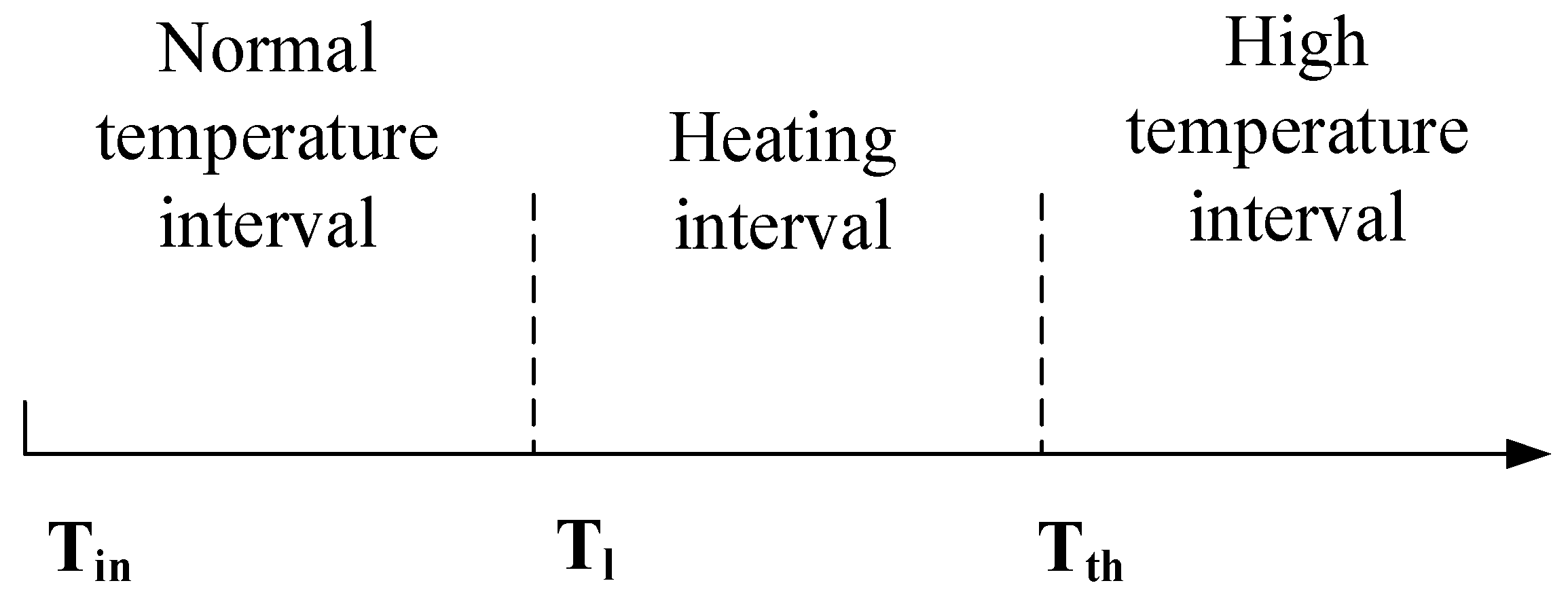
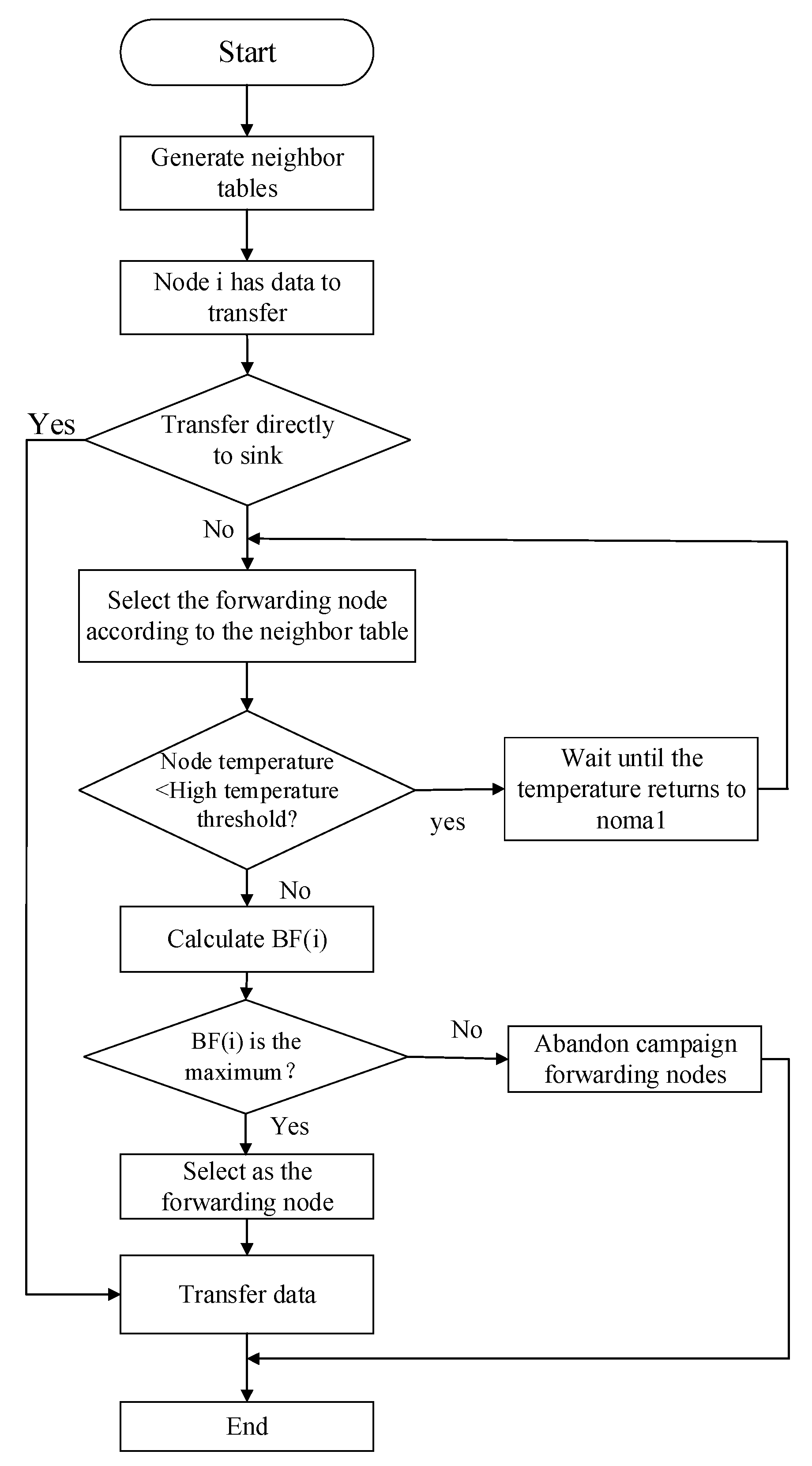

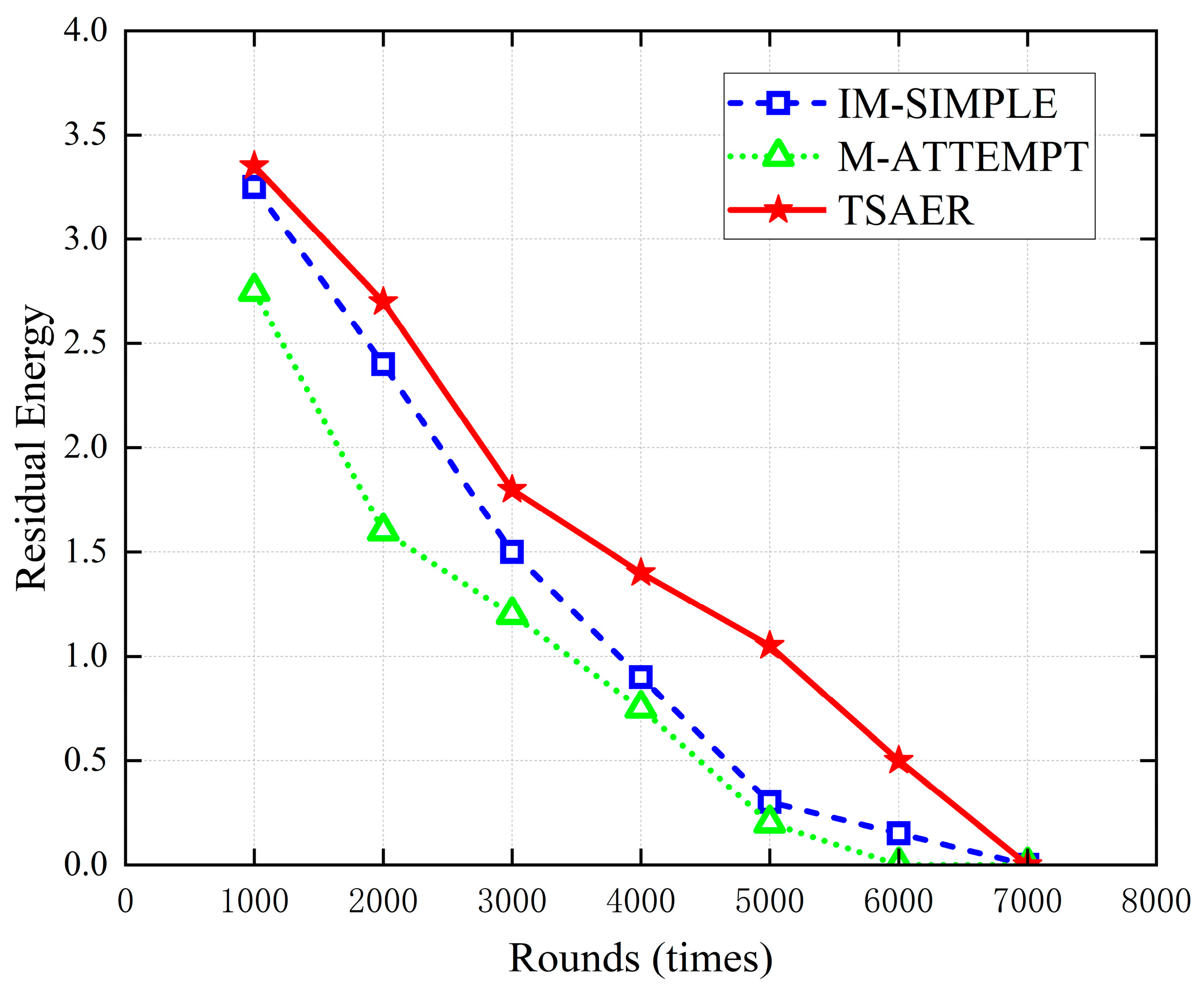
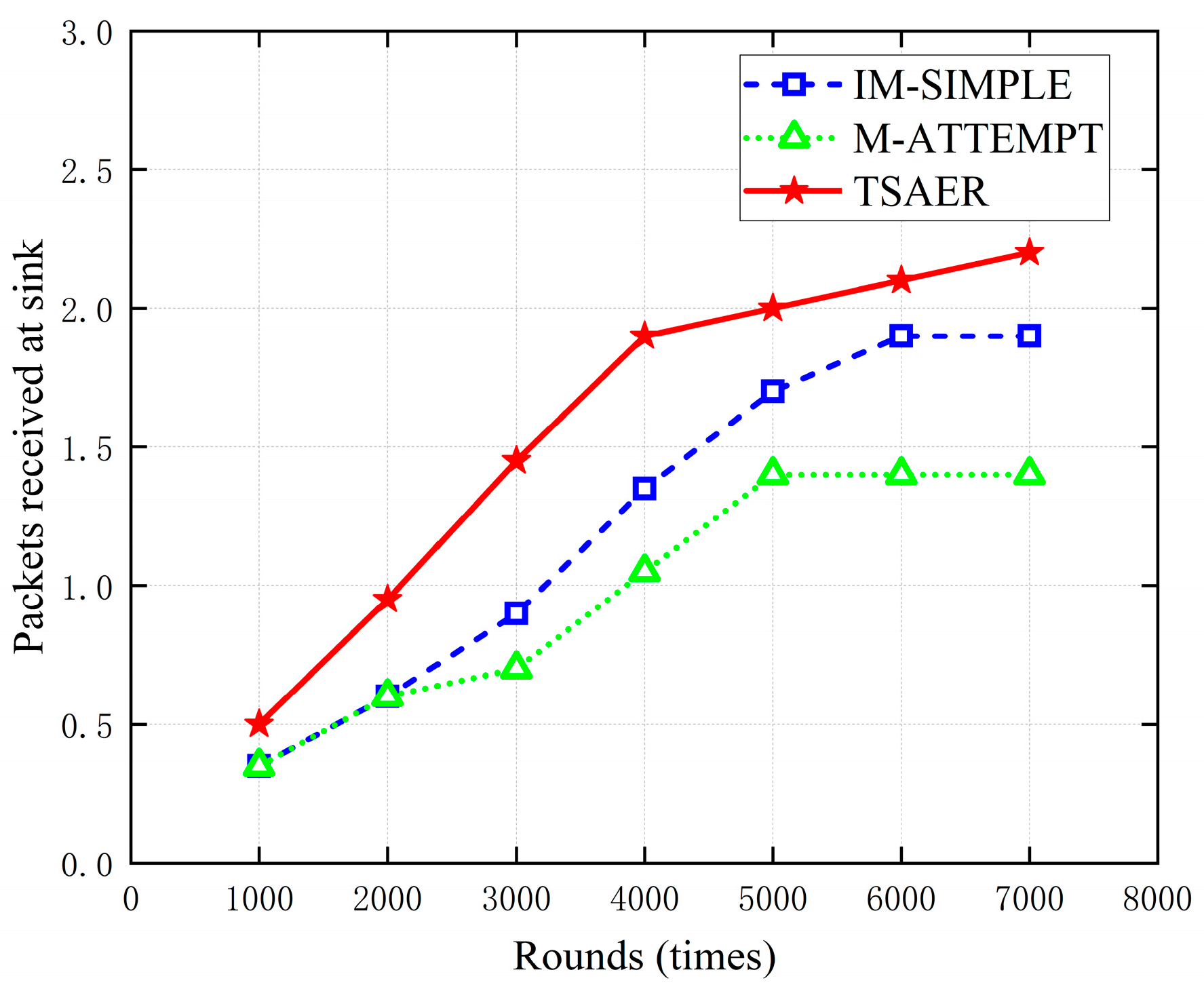
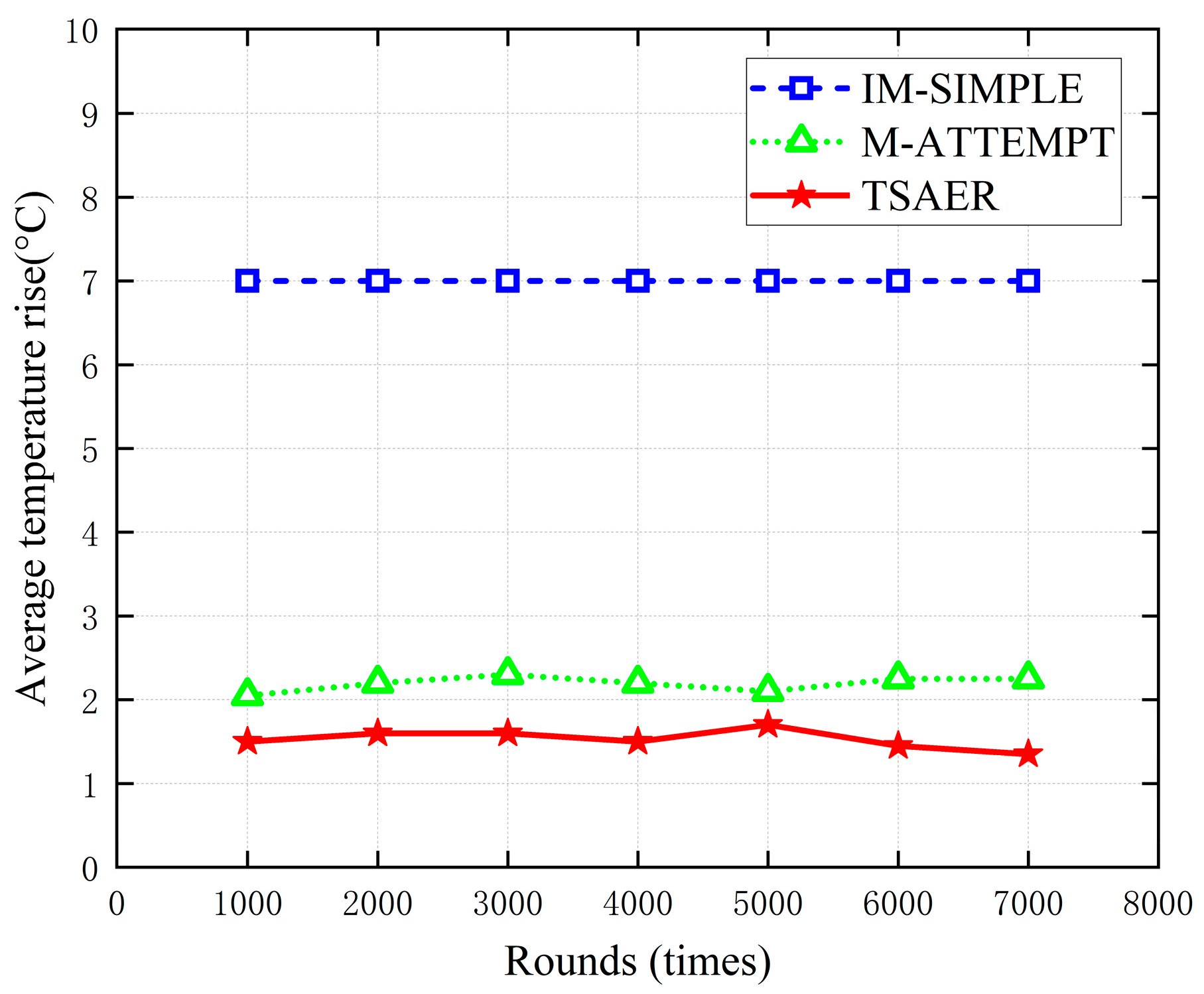
| Data Receiving Probability P | Normal Temperature Interval | Heating Interval | High-Temperature Interval |
|---|---|---|---|
| Emergency data P1 | 1 | 1 | 0 |
| Normal data P2 | 1 | (t2 − 2 Ttht + Tth2)/(T1 − Tth)2 | 0 |
| Parameters | Value |
|---|---|
| Initial energy | 0.5 J |
| Transmission energy | 16.7 nJ/bit |
| Receive energy | 36.1 nJ/bit |
| Data aggregation energy | 5 nJ/bit |
| Amplifier energy | 1.97 × 10−9 |
| Initial node temperature | 37 °C |
| Node temperature threshold | 43 °C |
| Node temperature low threshold | 39.5 °C |
| Temperature drop at nodes after each round of sleep | 0.02 °C |
| Specific heat Ts | 3600 |J/kg°C| |
| Thermal conductivity K | 0.498 |J/ms°C| |
| Blood perfusion constant b | 2700 |J/m3s°C| |
| Fixed blood temperature Tb | 37 °C |
| Time step δt | 10 s |
Disclaimer/Publisher’s Note: The statements, opinions and data contained in all publications are solely those of the individual author(s) and contributor(s) and not of MDPI and/or the editor(s). MDPI and/or the editor(s) disclaim responsibility for any injury to people or property resulting from any ideas, methods, instructions or products referred to in the content. |
© 2025 by the authors. Licensee MDPI, Basel, Switzerland. This article is an open access article distributed under the terms and conditions of the Creative Commons Attribution (CC BY) license (https://creativecommons.org/licenses/by/4.0/).
Share and Cite
Mu, Y.; Zheng, G.; Wang, X.; Zhu, M.; Ma, H. Temperature State Awareness-Based Energy-Saving Routing Protocol for Wireless Body Area Network. Appl. Sci. 2025, 15, 7477. https://doi.org/10.3390/app15137477
Mu Y, Zheng G, Wang X, Zhu M, Ma H. Temperature State Awareness-Based Energy-Saving Routing Protocol for Wireless Body Area Network. Applied Sciences. 2025; 15(13):7477. https://doi.org/10.3390/app15137477
Chicago/Turabian StyleMu, Yu, Guoqiang Zheng, Xintong Wang, Mengting Zhu, and Huahong Ma. 2025. "Temperature State Awareness-Based Energy-Saving Routing Protocol for Wireless Body Area Network" Applied Sciences 15, no. 13: 7477. https://doi.org/10.3390/app15137477
APA StyleMu, Y., Zheng, G., Wang, X., Zhu, M., & Ma, H. (2025). Temperature State Awareness-Based Energy-Saving Routing Protocol for Wireless Body Area Network. Applied Sciences, 15(13), 7477. https://doi.org/10.3390/app15137477





